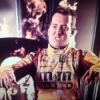During the month of May Rick Shaffer celebrated the beginning of the second century of “The Greatest Spectacle in Racing” with 101 different facts and figures on the race and Indianapolis Motor Speedway.
Link
Because I do not know how long they will be available on the National SpeedSport News website I show them here.
1.
Although it is pretty well known that the founders of the Indianapolis Motor Speedway were Carl Fisher, James Allison, Arthur Newby and Frank Wheeler, there originally were five partners in the group.
The aforementioned quartet were all involved in the automobile industry, so it seemed fitting that the fifth gentleman would be a banker. His name was Stoughton Fletcher and he came from a prominent banking family in Indianapolis. Unfortunately, members of his family did not like the idea of his participation “with the automobile types” and he was forced to sell his investment back to the partners.
2.
Ironically, the Fletcher family’s firm, American Fletcher National Bank, ultimately became involved in the Indianapolis 500 as the second company to sponsor the prestigious Rookie of the Year Award.
3.
After considering a couple of sites, Fisher was shown property on the intersection of an unnamed street that later became 16th St. and what are now Georgetown and Crawfordsville roads. There were 320 acres of flat farmland available, but what might have put the sale over the top was when realtor Lem Trotter showed Carl Fisher the railroad track that headed southeast to downtown Indianapolis.
Ever the visionary, Fisher could see how mass transportation could haul thousands of fans to and from the track. In fact, there was rail service to the track through 1963.
4.
Although the partners originally wanted a three- or five-mile “speed circle,” the shape of the property – one mile long by one-half mile wide – made it impossible to accommodate such a layout. The configuration of the property heavily influenced the design engineer’s decision to make the track rectangular in shape. And by the way, the plan was to call the new facility the “Indiana Motor Parkway.”
5.
Without any warning while the track was being constructed, the partners’ letterhead bore the name of Indianapolis Motor Speedway Co.. There was no press release announcing the name change from the rather mundane “Indiana Motor Parkway” and no one seems to know whose idea it was to change it or who came up with the new name.
6.
During the construction of the track, a color postcard was produced featuring an artist’s rendering of the new Speedway. It showed large grandstands filled with fans, cars on the 2.5-mile rectangular track as well as cars on the 2.5-mile infield road course. The latter was not be built for 90 years as Fisher wanted to keep the infield open to allow airplanes to take off and land.
7.
It was a sign of the times. To advertise it spacious infield in 1909, IMS offered that there were parking spaces for 10,000 automobiles and 3,000 hitching posts for horses.
8.
When the first automobile races were run in August of 1909, there were a number of serious accidents due to the gravel-and-tar surface that broke up and formed ruts. Canadian driver Wilfred “William” Borque and his riding mechanic Harry Holcomb became the track’s first fatalities when their car flipped in turn four.
Borque, who had postponed his wedding so he could race at the new Indianapolis track, became the first of thus far 40 drivers to lose their lives at IMS. Holcomb became the first of 13 riding mechanics killed at the track.
9.
Two days after the Borque-Holcomb accident, an accident in turn one resulted in the deaths of riding mechanic Claude Kellum and spectators James West and Homer Jollif. With five fatalities in three days, the local newspapers now referred to IMS as “the death track.”
The media called for a ban on auto racing and urged the track owners to permanently close the facility.
10.
Fortunately, cooler heads prevailed and the founders announced they would make the track safer by repaving with a material less prone to break up. Asphalt was briefly considered, as was concrete, but brick was chosen when it was shown to be easier to maintain.
Today, it is estimated that 85 percent of the 3.2 million bricks used (2,720,000 bricks) are still where they were originally placed by the construction crews —under layers of asphalt.
11.
Concrete had been a strong candidate in 1909 because there was already an established auto racing facility that used concrete for its surface.
The Brooklands in England was the first purpose-built auto-racing track in the world and Indianapolis was second. Races were held until 1939 when England entered World War II. During the war, part of the Brooklands track was damaged in a bombing raid and it was never repaired.
12.
For 1910, races were planned for the weekends of Memorial Day, July 4 and Labor Day. Although the Memorial Day crowds were large, the other two holiday weekends saw such a drop that the founders decided to have only one big race the following year – the Indianapolis 500.
13.
The famous Marmon Wasp got its nickname from a newspaper headline writer. Previously, the car had been referred to as the Marmon Yellow Jacket or the Marmon Bumblebee. When neither of those nicknames would fit in the headline of one of the local newspapers, the word “Wasp” was chosen because it would fit. It quickly caught on.
14. By the way, the famous “world’s first automotive rear-view mirror” that Ray Harroun affixed to the Marmon Wasp to quell a protest over his lack of a riding mechanic did not work very well.
In later years, Harroun admitted the roughness of the brick surface made the mirror vibrate so much he could not see out it.
15.
Although the box score lists them as rookies, of the 40 starters in the inaugural Indianapolis 500, at least 15 had won races staged at the track in 1909 and 1910.
16.
While Ray Harroun gets credit for leading the most important lap of the 1911 race (the 200th), Johnny Aitken led the very first lap of the first Indianapolis 500.
17.
And then there was Art Greiner. He has the unfortunately distinction of finishing last in the first 500. Sadly, he was eliminated by an accident on lap 12 in which his riding mechanic, Sam Dickson, was killed. Dickson became the first fatality in the Indianapolis 500.
18.
In 1912, Ralph DePalma dominated the proceedings, leading 196 of 200 laps and heading second-place driver Joe Dawson by more than five laps when his engine expired on lap 199.
For his efforts, DePalma received nothing as IMS only paid the first 10 finishers. And because the speedway did not offer prize money for laps led until 1920, DePalma’s lofty 196-lap effort went without any financial reward.
19.
Jules Goux found much to like about racing at Indianapolis. In addition to winning the 1913 race by a record margin of 13 minutes and eight seconds over American driver Spencer Wishart, he later met the woman of his dreams. In 1922, he married Ruth Davis of Indianapolis.
20.
It took four races, but in 1914, the Indianapolis 500 finally had a defending winner in the starting field. Jules Goux, the 1913 winner, finished fourth in 1914. Ray Harroun had retired after the 1911 race and Joe Dawson missed the 1913 event due to an injury.
21.
Of the 30 starters in the 1914 Indianapolis 50, there was one the larger classes of rookie drivers with 15. * Three of those rookies will perish in World War I that will start in the fall of that year.
Frenchman Georges Boillot, who finished 14th, will be killed in aerial combat over France in 1916. The last-place finisher, S.F. Brock, will be lost at sea after his submarine sunk in 1918. Another 1914 rookie, George Mason, was killed in action in France as an American Red Cross ambulance driver less than two months before the end of the war.
(* I can’t help it; that is the way NSSN published it.)
22.
George Mason had another distinction. In 1914, he was the first driver to race in the 500 to carry the No. 13. That distinction will last until 2003 when Greg Ray also used that number. Ray also used No. 13 in his final 500 start in 2004.
23.
One member of the rookie class of 1914 might actually have been the most famous racing driver in the United States at the time. But because it was his first start in the 500, Barney Oldfield was numbered among the rookies. One could say he finished first in class as he wound up fifth behind four European drivers and also had the highest-placed American car, a Stutz. Had there been a Rookie of the Year Award at the time, however, it might have been difficult to vote for Oldfield.
Rookies Rene Thomas and Arthur Duray finished first and second. Oldfield will also compete in the 1916 race and once again finished fifth.
























